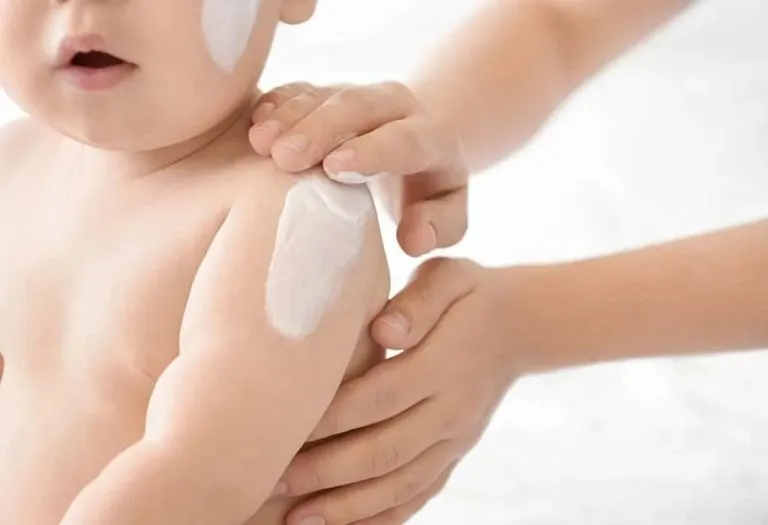Is Zinc Oxide Safe for Babies?

Zinc oxide is an ingredient which is quite common in many commercial diaper rash ointments. But many parents may ask, ‘Is zinc oxide safe for my baby?’ You may not know, but zinc oxide is a popular ingredient in several other products as well, such as sunscreens, lotions, baby powders, and more. Since it is available in so many baby products, don’t you think that before you give this mineral a green light, you should know whether it is safe for your little munchkin? If you agree, then accompany us as we uncover some pertinent facts about zinc oxide and how safe it really is for your baby.
What Is Zinc Oxide?
Zinc oxide is a white mineral in the form of a powder which does not dissolve in water (5). It has excellent properties of making a protective barrier on your skin. For this reason, it is the active ingredient used in baby rash ointments and is also a key ingredient used to make sunscreens and other types of first-aid ointments (1).
Should You Use Zinc Oxide Products on Babies?
People usually fear zinc oxide due to the perceived health risks of zinc oxide nanoparticles entering the bloodstream. However, according to research, zinc oxide particles which are larger than 30nm are not absorbed by the body when used in lotions or creams. According to Harvard, when zinc oxide is used in medical preparations, it is quite safe for babies, and doctors usually recommend it for treating diaper rashes in babies (2). Also, zinc oxide is usually mixed with other ingredients to create ointments which have anti-inflammatory and soothing properties, further protecting your baby’s delicate skin (3). As with other over-the-counter medicines, make sure to use the ointment containing zinc oxide strictly as indicated.

Uses of Zinc Oxide
Zinc oxide is used to treat a variety of skin ailments. Here are some of its uses listed below:
- You can use zinc oxide for baby sunscreen as it will not dissolve in water, making it perfect to use by the pool or beach. Also, it effectively absorbs UV radiation and can protect your baby’s skin from UVA and UVB ultraviolet sun rays (4). Since babies’ metabolic and excretory pathways aren’t developed fully yet and they have extremely absorbent skin, it is better to consult a paediatrician before using any sunscreen containing zinc oxide for babies under six months (5).
- You can use zinc oxide for your baby’s diaper rash as it can ease any irritation or itching caused by it (3).
- You can use zinc oxide in baby powder as it has soothing properties.
- Using zinc oxide cream for baby eczema is also an effective form of treatment.
- Zinc oxide can also be used to cure itching caused by sunburn, insect bites and rashes from plants (4).

How Does Zinc Oxide Work?
Zinc oxide is usually mixed with other substances to create a waterproof ointment. Since zinc oxide has soothing properties, when combined with the moisture barrier of the ointment, it can treat diaper rash and protect the baby’s skin from any diaper rash in the future as well. A diaper rash cream containing zinc oxide will be thicker than one without zinc oxide and, hence, will be a little more difficult to wash off, courtesy of the moisture barrier in the cream.
Side Effects of Zinc Oxide on Infants
Although an allergic reaction to zinc is highly rare, it is still possible if an individual has an accidental exposure to zinc through ingestion or inhalation of its fumes (6). Since fume exposure to zinc can only happen in an industrial setting, that leaves us with ingestion. It could happen if a baby ingests a product containing zinc oxide in it, such as baby lotion, calamine lotion, or baby powder. Ingestion could lead to zinc oxide poisoning, of which the common side effects include (7) (8):
- Stomach cramps
- Vomiting
- Diarrhea
- Mouth and throat irritation
- Chills and fever
- Cough
- Yellow skin and eyes
What Are the Limitations of Zinc Oxide Ointments?
Still, is zinc oxide bad for babies? The answer is no, but there are some limitations. Firstly, it is difficult to wash off, and secondly, it does not kill yeast or bacteria. Therefore, if zinc oxide ointment is used for a week, but your baby’s diaper rash is still not cleared, there may be the possibility that an infection has developed. This is not uncommon as the faecal matter, moisture, and yeast present in the body make the diaper region of the skin quite susceptible to infection. Zinc oxide’s side effects can also occur if babies are allergic to any ingredient in the ointment, like zinc, lanolin, petroleum, wax or parabens.
Precautions and Considerations

Observe the following precautions when using zinc oxide ointments:
- When you are using zinc oxide for treating diaper rash, change your baby’s diapers regularly so that they don’t trap heat and moisture, further irritating your baby’s skin.
- The general consensus among parents who use cloth diapers is that zinc oxide ointments/creams shouldn’t be used if your baby wears a cloth diaper, as petroleum can build up on the cloth and cause it to repel liquids instead of absorbing them.
- Ensure any zinc oxide-based item is not in reach of the baby’s mouth to avoid zinc oxide poisoning.
FAQs
1. What are some products that have zinc oxide in them?
Zinc oxide is found in plenty of different products, such as diaper rash ointments, zinc oxide ointments, body lotions, calamine lotions, mineral sunscreens, paint, caladryl lotions, rubber products, paper coating, etc (6).
2. Is zinc oxide safe for newborn babies?
Yes, zinc oxide is safe for topical treatment in newborn babies. It can be found in a diaper rash cream to treat diaper dermatitis (1) (3).
3. Besides diaper rash, can zinc oxide-based products be applied on the face?
Yes, zinc oxide-based creams like calamine lotion are safe to be used on babies’ faces and there were no side effects. Therefore, baby lotions and creams containing zinc oxide are safe to be applied on the face (9).
Using zinc oxide for babies is generally considered safe. However, it is always better to know the pros and cons of zinc oxide. When it comes to the products you use on our little ones, you can never be too careful!
References/Resources:
1. Newborn Skin 101; Johns Hopkins Medicine; https://www.hopkinsmedicine.org/health/wellness-and-prevention/newborn-skin-101
2. Zinc oxide shows no link to skin damage; Harvard Medica School; https://www.health.harvard.edu/staying-healthy/zinc-oxide-shows-no-link-to-skin-damage; April 2019
3. Gupta. M, Mahajan. V. K, et al.; Zinc therapy in dermatology: a review. Dermatol Res Pract., PubMed Central; https://www.ncbi.nlm.nih.gov/pmc/articles/PMC4120804/; 2014
4. The Best Sunscreen Tips for Kids; Children’s Hospital Colorado; https://www.childrenscolorado.org/conditions-and-advice/parenting/parenting-articles/sunscreen-tips-for-kids
5. Zinc Oxide; PubChem; National Center for Biotechnology Information; https://pubchem.ncbi.nlm.nih.gov/compound/Zinc-oxide#section=Information-Sources
6. Zinc oxide overdose; MedlinePlus; https://medlineplus.gov/ency/article/002571.htm
7. Abendrot. M, Kalinowska-Lis. U; Zinc-containing compounds for personal care applications; International Journal of Cosmetic Science, Volume 40, Issue 4, https://onlinelibrary.wiley.com/doi/epdf/10.1111/ics.12463; August 2018
8. Calamine Lotion; Children’s Hospital of Philadelphia; https://www.chop.edu/centers-programs/poison-control-center/calamine-lotion
9. Kim. K. S, Sinniah. D, Kee. T. K; Neonatal rash A case study; Australian Family Physician; https://www.racgp.org.au/afp/2012/september/neonatal-rash; September 2012
Also Read:
Aloe Vera for Infants
Is Ubtan Safe for Babies?
Hydrocortisone Cream for Infants
Safe & Unsafe Mosquito Repellents for Babies
Was This Article Helpful?
Parenting is a huge responsibility, for you as a caregiver, but also for us as a parenting content platform. We understand that and take our responsibility of creating credible content seriously. FirstCry Parenting articles are written and published only after extensive research using factually sound references to deliver quality content that is accurate, validated by experts, and completely reliable. To understand how we go about creating content that is credible, read our editorial policy here.























